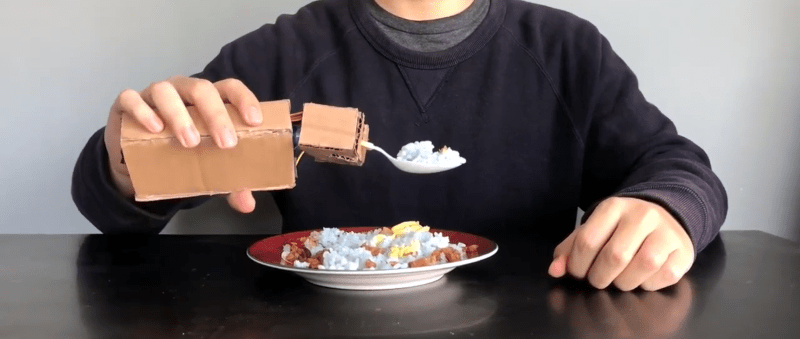When we first saw [Barqunics’] design for a self-stabilizing spoon for people suffering from Parkinson’s disease, we wondered how well something like that could work. But take a look at the video below and you’ll see this does a fine job of responding to the user’s hand movements and keeping the spoon perfectly level through a wide range of motion.
There’s at least one commercial product that attempts to stabilize a spoon in the same way so that people suffering from that affliction can retain a measure of independence. This shows that you don’t need injection molding and factory made boards to prove the concept. An MPU6050 provides sensor information and two servo motors control the spoon using PID control.
PID — short for proportional, integral, derivative — is a way to adjust something to a desired point. For example, consider trying to heat a cup of water to 95 °C. If you simply turn the heater on full blast until you get to 95 °C, the water will actually get hotter because you’ll overshoot. Using PID, the amount of heating provided will depend on how far off you are now (proportional), how far off you’ve been over the long term (integral), and how much change you’ve effected recently (derivative). The same algorithm works for spoon-balancing and many other types of controls.
This isn’t the first bootstrapped assistive spoon project we’ve seen. We even looked at the commercial version, awhile back.
















Congratulations, for making the world better
This is awesome, but i would like to see it handling the proper vibration of a real hand with parkinson’s. It would need some tuning I’m guessing, but yeah, real world scenario would involve more acceleration/jerk/jank control, i really hope it takes that in consideration and helps a bunch of people, cheers
Yup… What a painful video to watch, 85% of it is just plugging in wires. Jump to 3:13/3:47 to finally see the spoon “work”, or use the link below. I’m also not clear how this motorized spoon will benefit a person with Parkinson’s. I doubt it could react fast enough to counteract any trembling or shaking motion. That was not demonstrated.
https://youtu.be/LCNvCwMxjFk?t=193
https://youtu.be/LCNvCwMxjFk?t=193
Could stand to have something like this for my soldering iron…
OMG! YES!
Fast forward to 2021:
https://hackaday.com/2021/06/04/soldering-iron-plus-camera-gimbal-helps-cancel-out-hackers-hand-tremors/
Best regards,
A/P Daniel F. Larrosa
Montevideo – Uruguay
That’s so much better than the millionaire’s spoon made by Google some years ago, congrats.
Nothing novel here. Look for “Liftware Level”, it’s dated at 2016. Probably similar devices were constructed even earlier.
Very cool project! This could have such good uses… It isnt really PID though right? The I and D part are just turned off.
Yes, it‘s only a P controller.
Very cool. Congratulations. Nice project. :)
My son did one at the beginning of this year for his middle school and Santa Clara Science Fair and worked pretty well. He got an honorary award for that. Last year he did a Haptic Glove for visually impaired people and got a few prizes as well. For those project we talked to some people with Parkinson’s and Hand Tremors and they loved the idea. That also gave us a good reason for buying a 3D printer and do the enclosure with it.
Again kudos for this project. It feels great when people can contribute to other’s needs with such ideas.
Now just replace the spoon with a soldering iron. C’mon fellow shaky hackers, we don’t need to eat; we need to solder!
Fast forward to 2021:
https://hackaday.com/2021/06/04/soldering-iron-plus-camera-gimbal-helps-cancel-out-hackers-hand-tremors/
Best regards,
A/P Daniel F. Larrosa
Montevideo – Uruguay
Neat idea, but has it been tested with someone with Parkinson’s? The tremors of Parkinson’s are much faster than the slowly turning the spoon to demonstrate the range of movement done in the video. So I’m inclined to think that this would provide little to no benefit, as the servos aren’t that fast.
If this works, great, but we need to make sure we’ve understood the needs and got the spec correct before we swoop in to solve things for people.
Nice proof of concept. But now come the challenges. To scoop something from a plate, you don’t want the spoon to be horizontal, but have a slight angle down. And to put the spoon in your mouth, you need to rotate it so that the front points towards you mouth.
Question is: how are you going to switch between those functions? You can’t ask a person with parkinson’s disease to press some tiny buttons on the device…
May be a possible solution is to add a cheap ultrasonic distance sensor, facing downwards, measuring the hand – table distance in real time to make the desired adjustments to the spoon:
– distance is greater than “X”: keep the spoon horizontal and rotate it so that the front points towards the mouth
– distance is less than “Y”: move the spoon a slight angle down, so as to scoop something from the plate
Another possibility: using a metalilc plate or bowl and a metallic spoon, detect the contact or measure the resistance between them.
Best regards,
A/P Daniel F. Larrosa
Montevideo – Uruguay
For making the actuators faster you could try a stepper motor from old cd or diskette drives, considering that the torque needed is not to high. I will try to used and start probes in the future, i hope to see you improving your desing, good luck.
This makes me wonder whether a purely mechanical stabilizer with a counterweight might not help with soldering for those of us who don’t have any medical condition, but simply are short on fine motor skills. Though it would be hard to set up so the frame doesn’t constantly get in the way.